As we begin our collaboration with museums to examine their African collections, we run into familiar challenges. Geography, music, and art don’t fit neatly into the borders most people associate with Africa. These borders—lines on maps that now divide countries—were never part of the cultural fabric that existed long before colonial powers imposed them. These lines weren’t just drawn without Africa in mind; they were drawn against it, designed to divide great kingdoms, disassemble communities, and control resources.
Take the Akan people, for example. From Côte d’Ivoire to Nigeria, and I would argue as far as the Congo and beyond, the influence of the Akan people spreads deep and wide. Yet modern maps tell us we’re separate. Our culture, history, and shared knowledge say otherwise.
This issue comes to light when we look at the recent return of artifacts from the British Museum and the V&A. They weren’t simply handed back to a “country”—they were returned to the Asantehene, the Ashanti king. But here’s where the narrative becomes even more complex: What does it mean for these artifacts to go back to the king? Some might see him as a descendant of those who collaborated with the British, while others recognize him as the successor of warriors like Nana Yaa Asantewaa, who fiercely resisted colonization.
However, we must also acknowledge a harsh truth: not everyone resisted colonialism. There were those who benefited from it—some of whom still hold significant power today. Returning treasures stolen from warlords to the descendants of slave traders isn’t decolonizing history; it’s repeating old patterns of exclusion. We must question whether this type of restitution is truly a good thing. Is it justice to return stolen artifacts to people whose ancestors participated in systems of exploitation, even as others fought against them?
So, what’s being returned? Is it just the physical objects, or is it something deeper—a cultural restoration that goes beyond borders and colonial constructs? Because the truth is, our identities as African people can’t be confined to these modern-day lines. The Akan kingdoms, and many others across Africa, transcend these imposed divisions, which were designed to weaken the bonds that have tied us together for centuries.
But perhaps the hardest work remains within Africa itself. Decolonizing our minds and societies is a monumental task when many of us are still claiming nationalities that are the embodiment of colonialism. We identify with countries whose borders were drawn not by us, but by outsiders, often with the goal of fracturing and weakening our kingdoms. How do we truly free ourselves when the very idea of our “nations” is rooted in colonial design?
As we work with museums, we need to challenge these narratives and remind the world that while Africa may not be a country, the arbitrary borders carved by colonialism don’t tell our story either. Our history is far more ancient, our kingdoms far more expansive, and our connections far deeper than any map could ever show.
The question isn’t just about where these artifacts are returned. It’s about to whom they truly belong—kingdoms or countries? Or perhaps they belong to something larger still: the collective memory and identity of our people. Let’s start asking the right questions.
Our culture predates colonialism and will outlast it. It’s up to us to shape how it’s remembered, and, crucially, how we remember ourselves. The path to decolonization doesn’t just involve returning stolen artifacts—it involves reclaiming the very narratives and identities that were taken from us. Only then can we truly be free.






0 Comments